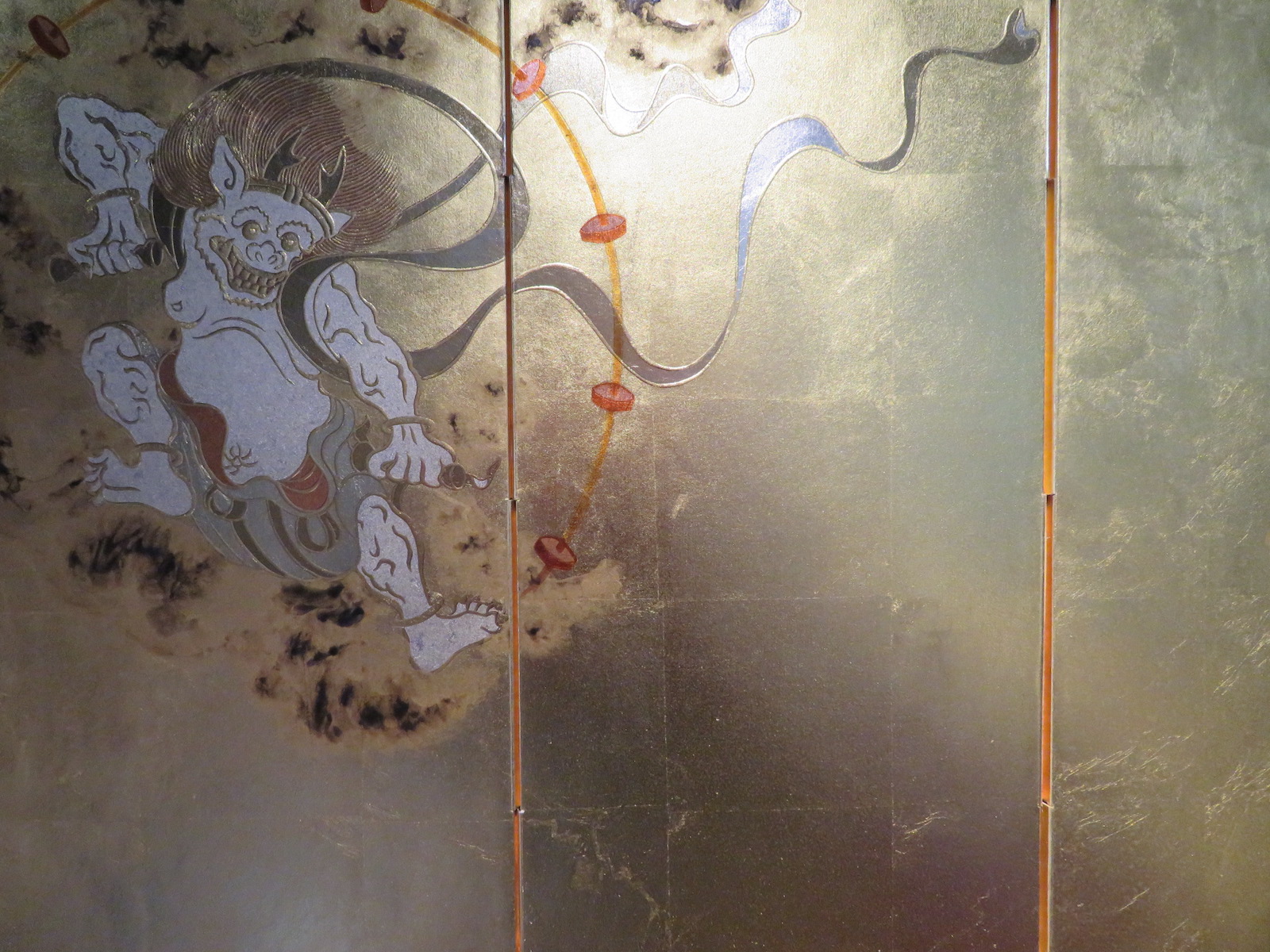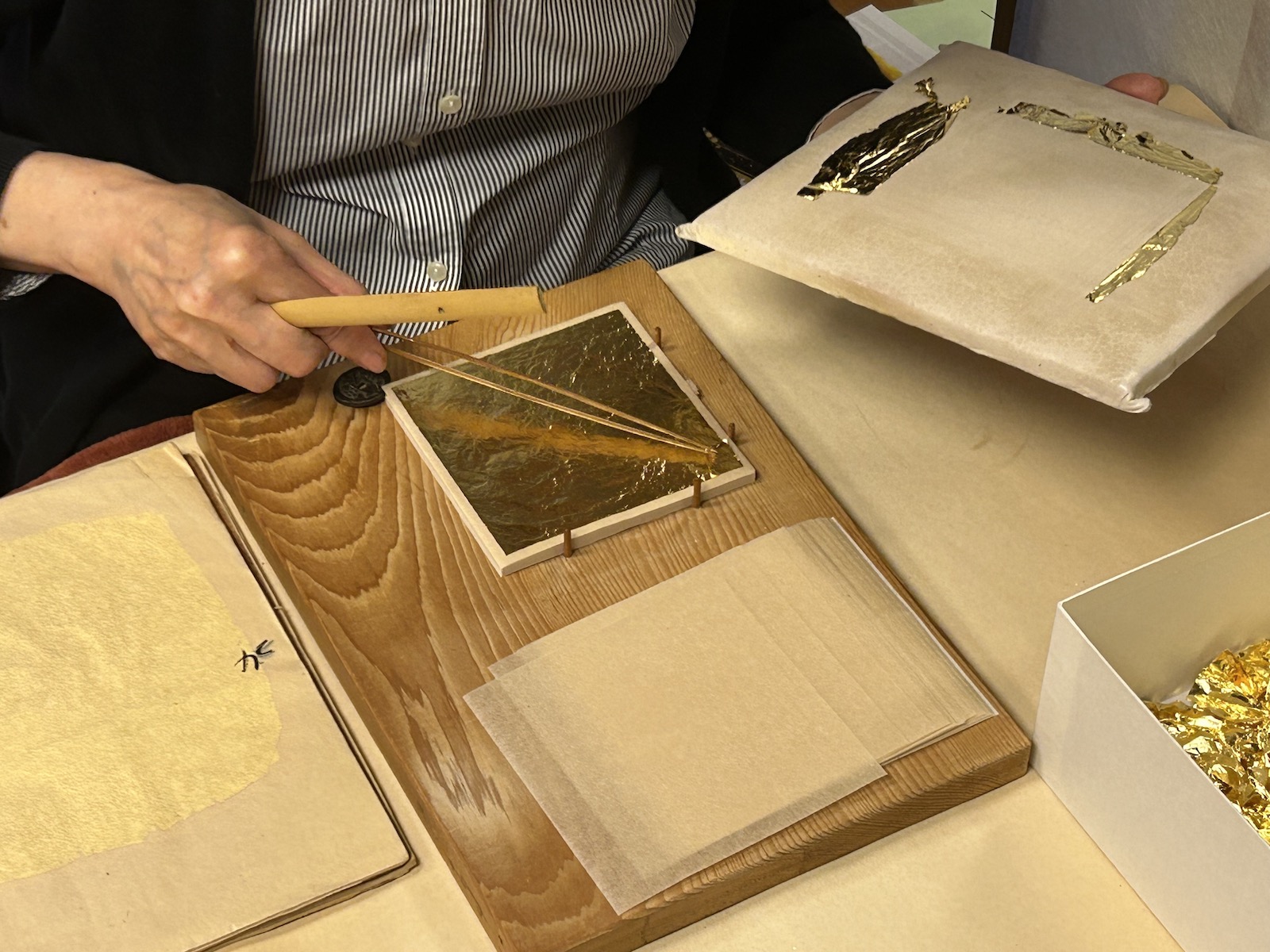Centuries ago, farmers washing their produce in the spring at their local shrine observed glints of gold left in the water and realized there was gold in the soil their crops were grown in. The area became known for its gold and the community took its name from that gold-flecked water: Kanazawa (literally Golden Stream).

Kanazawa is now the capital of modern Ishikawa Prefecture on the Sea of Japan, with a long and illustrious history and much to recommend it as a tourist destination. While the gold in this area was long ago mined out, the city retains its fame as the number one producer of gold leaf in Japan, responsible for the creation of nearly all of the extremely thin sheets of gold alloy made in Japan.
Gold leaf is used in a wide variety of decorative arts in Japan. It decorates the walls of temples and the surfaces of byobu (folding screen room dividers), boxes and other containers, as well as statues and carvings. It also features largely in jewelry production, an evolution from its use to decorate sword handles and other traditional samurai implements of a bygone age.

Production is a painstaking and time-consuming process that has been highly refined since being introduced in Japan from China, possibly as early as the third century.
It is perhaps to be expected that Kanazawa, as a place where gold itself was extracted from the earth, would take the lead as a gold leaf producer, but in fact it was not until the late 16th century that gold leaf production was introduced to Kanazawa. And the craft was soon snatched away, when the Tokugawa shogun mandated that gold leaf could only be produced in his capital of Edo. Production did not return to Kanazawa until the nineteenth century, when restrictions were relaxed and gold beaters arrived from Kyoto to assist with the reconstruction of the city’s fire-damaged castle. Since then, however, Kanazawa has come to dominate the field and the method of gold leaf production used is now registered as a UNESCO intangible cultural heritage.
This incredible history is explained at the Kanazawa Yasue Gold Leaf Museum, just around the corner from Kanazawa’s famed Higashi Chaya District. Just as the district is a must-see for visitors to Kanazawa, a trip to the museum is a must for visitors to the district. It is worth noting that this Kanazawa neighborhood was historically, and remains today, the home of most of Kanazawa’s gold beaters.
The museum’s permanent collection comprises displays on gold and gold leaf production, showing how a bar of gold becomes thousands of lustrous super-thin sheets.

A surprising key ingredient to the process is a special kind of washi paper known as haku uchigami that is placed between the 5 centimeter-square stretched gold sheets of 1/20 mm. thickness as they are pounded ever thinner, ensuring that they thin without sticking. The process for making that paper is explained in the museum, together with displays on the traditional and modern gold-beating processes that result in gold leaf that is 1/10,000 mm thick.

The museum has a separate “temporary” gallery, rotating displays of objets d’art and other items made using gold and gold leaf. Included are antique ceramics, whimsical figurines and Buddhist altars. Precious antique kimono made with fabric interwoven with gold threads or adorned with intricate embroidery of gold are also often featured.
To fully appreciate the breadth of uses of gold leaf, step around the corner to Kinpakuya Sakuda, a shop offering a wide variety of gold leaf items.
The store has an attached workshop where visitors can quietly observe the finished gold leaf being trimmed and packaged or even being applied to objects. It is interesting to learn that the leftover trimmings were once used as edible gold flakes (apparently that product is produced differently post-COVID).

Four times a day (9:00, 10:30, 13:00 and 15:00) visitors to Sakuda can also have a 60 minute gold leaf experience, applying gold leaf to chopsticks, small dishes, or a number of other items for everyday use to make a personalized souvenir of Kanazawa.
The ground floor of the shop has various consumer items made with gold leaf, often small, affordable souvenir items. Step upstairs to see the true art of gold leaf—perhaps a piece for the lobby of your corporate headquarters?
For one of those “only in Japan” experiences, pop into both the men’s and ladies’ rooms upstairs. One is covered in gold leaf and the other in silver leaf. Dazzling!
Back in Higashi Chaya, there is one last must-see spot for gold leaf: Hakuza Hikarigura. From the outside, this may look like just another shop featuring high-end items made with gold leaf—and they have plenty of distinctive wares on offer — but step into the courtyard toward the back to find the kura (traditional fire-proof warehouse), with outer walls covered in gold leaf from which the shop derives its name: Hikarigura (sparkling warehouse).

Visitors to Kanazawa will find items of gold and gold leaf everywhere, but this little corner of the city undoubtedly provides the best introduction and understanding of this beautiful material. As a final example of the ubiquitousness of gold leaf in Kanazawa, be sure to look up when on the Shinkansen platform at Kanazawa station. Even the tops of the pillars in the station are covered in gold leaf.
Kanazawa Yasue Gold Leaf Museum: 9:30-17:00 (closed Mondays and New Year’s); admission 310 yen.
Kinpakuya Sakuda: open daily, 9:00-17:00
Hakuza Hikarigura: open daily, 9:00-17:00
Vicki L Beyer, a regular Japan Today contributor, is a freelance travel writer who also blogs about experiencing Japan. Follow her blog at jigsaw-japan.com.
© Japan Today















1 Comment
Login to comment
wallace
Love Byobu's.